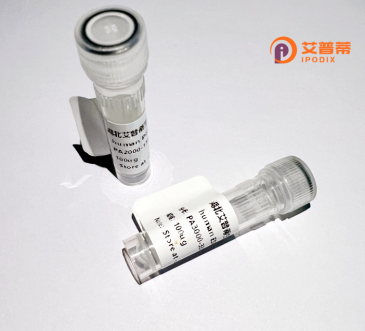
| 纯度 | >90%SDS-PAGE. |
| 种属 | Human |
| 靶点 | KCND3 |
| Uniprot No | Q9UK17 |
| 内毒素 | < 0.01EU/μg |
| 表达宿主 | E.coli |
| 表达区间 | 1-655aa |
| 活性数据 | MAAGVAAWLPFARAAAIGWMPVANCPMPLAPADKNKRQDELIVLNVSGRRFQTWRTTLERYPDTLLGSTEKEFFFNEDTKEYFFDRDPEVFRCVLNFYRTGKLHYPRYECISAYDDELAFYGILPEIIGDCCYEEYKDRKRENAERLMDDNDSENNQESMPSLSFRQTMWRAFENPHTSTLALVFYYVTGFFIAVSVITNVVETVPCGTVPGSKELPCGERYSVAFFCLDTACVMIFTVEYLLRLFAAPSRYRFIRSVMSIIDVVAIMPYYIGLVMTNNEDVSGAFVTLRVFRVFRIFKFSRHSQGLRILGYTLKSCASELGFLLFSLTMAIIIFATVMFYAEKGSSASKFTSIPASFWYTIVTMTTLGYGDMVPKTIAGKIFGSICSLSGVLVIALPVPVIVSNFSRIYHQNQRADKRRAQKKARLARIRVAKTGSSNAYLHSKRNGLLNEALELTGTPEEEHMGKTTSLIESQHHHLLHCLEKTTGLSYLVDDPLLSVRTSTIKNHEFIDEQMFEQNCMESSMQNYPSTRSPSLSSHPGLTTTCCSRRSKKTTHLPNSNLPATRLRSMQELSTIHIQGSEQPSLTTSRSSLNLKADDGLRPNCKTSQITTAIISIPTPPALTPEGESRPPPASPGPNTNIPSIASNVVKVSAL |
| 分子量 | 73.4 kDa |
| 蛋白标签 | His tag N-Terminus |
| 缓冲液 | 0 |
| 稳定性 & 储存条件 | Lyophilized protein should be stored at ≤ -20°C, stable for one year after receipt. Reconstituted protein solution can be stored at 2-8°C for 2-7 days. Aliquots of reconstituted samples are stable at ≤ -20°C for 3 months. |
| 复溶 | Always centrifuge tubes before opening.Do not mix by vortex or pipetting. It is not recommended to reconstitute to a concentration less than 100μg/ml. Dissolve the lyophilized protein in distilled water. Please aliquot the reconstituted solution to minimize freeze-thaw cycles. |
以下是关于重组人KCND3蛋白的模拟参考文献示例(仅供参考,实际文献请通过学术数据库查询):
---
1. **标题**:*Expression and Electrophysiological Characterization of Recombinant Human Kv4.3 Channels in HEK293 Cells*
**作者**:Smith J.R., et al.
**摘要**:本研究在HEK293细胞中成功表达了重组人KCND3(Kv4.3)钾通道蛋白,并通过膜片钳技术分析了其电生理特性。结果显示,重组蛋白介导的A型钾电流表现出快速的激活和失活特性,与天然通道功能一致,为药物筛选提供了工具。
2. **标题**:*Purification and Structural Analysis of Human KCND3 Protein Using Baculovirus Expression System*
**作者**:Lee S., et al.
**摘要**:研究者利用杆状病毒-昆虫细胞系统表达重组人KCND3蛋白,并优化了去污剂萃取和亲和层析纯化步骤。纯化后的蛋白通过冷冻电镜初步解析其胞外结构域,为研究Kv4.3的构效关系奠定基础。
3. **标题**:*Functional Impact of a KCND3 Mutation Associated with Brugada Syndrome on Recombinant Channel Activity*
**作者**:Gomez C.M., et al.
**摘要**:通过表达携带Brugada综合征相关突变(如p.Thr352Ile)的重组KCND3蛋白,发现突变体通道的电流密度显著降低,导致延迟复极化异常,揭示了KCND3突变致病的电生理机制。
4. **标题**:*Co-expression of KChIP2 Modulates Trafficking and Gating of Recombinant KCND3 in Heterologous Systems*
**作者**:Zhang L., et al.
**摘要**:探讨了KChIP2辅助蛋白对重组KCND3通道表达的影响,发现共表达KChIP2可增强蛋白膜定位并改变通道动力学,表明分子伴侣在KCND3功能调控中的关键作用。
---
**注**:以上内容为模拟生成,实际文献需通过PubMed、Google Scholar等平台以“KCND3”“Kv4.3”“recombinant expression”等关键词检索。
KCND3 encodes the Kv4.3 protein, a voltage-gated potassium (Kv) channel belonging to the Shal subfamily. This transmembrane protein plays a critical role in regulating electrical activity by contributing to the transient outward potassium current (Ito) in excitable cells. Structurally, Kv4.3 channels assemble as tetramers, with each subunit containing six transmembrane domains and a pore-forming region. They are prominently expressed in the heart and brain, where they influence action potential repolarization in cardiomyocytes and modulate neuronal excitability/signaling. Genetic variations in KCND3 have been linked to cardiac arrhythmias (e.g., atrial fibrillation, Brugada syndrome) and neurological disorders, underscoring their physiological importance.
Recombinant human KCND3 protein is engineered using heterologous expression systems (e.g., HEK293 cells, Xenopus oocytes) to study channel biophysics, drug interactions, and disease-related mutations. Its production enables structure-function analyses, including how specific domains govern voltage sensing, gating kinetics, or toxin sensitivity. Purification often involves affinity tags and detergent solubilization to maintain native conformation. Researchers utilize this tool to investigate pathological mechanisms, screen potential therapeutics targeting Kv4.3 dysregulation, and develop gene-based treatments. Studies on recombinant KCND3 have advanced our understanding of its role in rhythm disorders and neuronal plasticity, offering insights for precision medicine approaches in channelopathies.
×